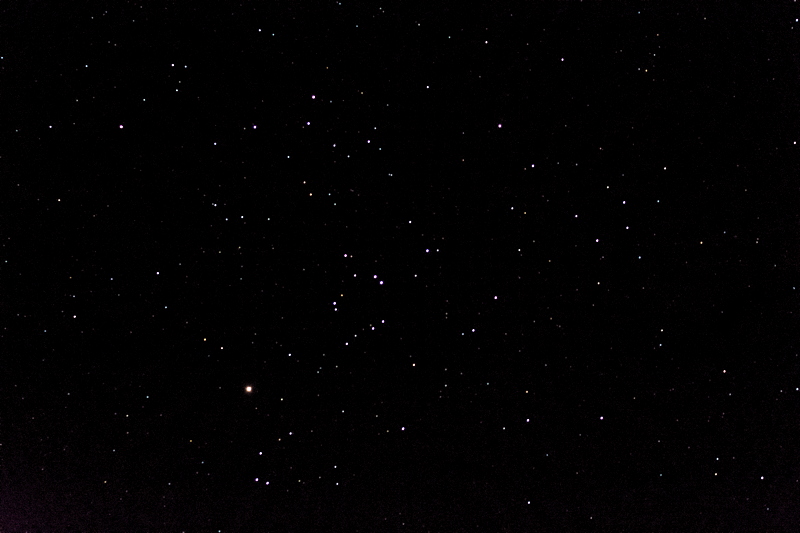Tamron 150-600mm lens tests:
Hyades, Pleiades, Lyra, Ring Nebula
Posted: 6 December 2015
Friday, 4 December 2015, dawned clear, but clouds began appearing mid-morning, with a forecast of a mostly cloudy night. The sky was mostly overcast by sunset. There was an excellent pass of the International Space Station shortly after sunset that was missed due to the clouds. Saturday dawned clear and the sky stayed that way.
|
Open: Saturday, 5 December 2015, 1659 MST Temperature: 72°F |
Session: 893 Conditions: Clear, some clouds west & north |
1708 MST: GOTO the star Fomalhaut and viewed it at 83X. 1715 MST: sunset. Added the focal reducer and mounted the D7200 DSLR at prime focus + focal reducer + diagonal to do a field-of-view (FOV) measurement. Oriented the camera viewfinder north-south, east-west, and slewed Fomalhaut up/down and left/right to the FOV edge. I noted the Declination and Right Ascension at each edge using the AutoStar MODE display. These measurements would be used to determine the FOV in degrees, minutes, seconds of arc (1°48'43" x 1°02'15").
I left the focal reducer on the 8" LX200-ACF for observing once the sky was dark enough. 1740 MST: viewed M45 (the Pleiades), 53X. Only the brightest stars were visible against the still bright sky. Made for a pretty sight. 1755 MST: the Pleiades was just becoming naked-eye visible. Astronomical Twilight would end at 1845 MST.
1815 MST: viewed the Double Cluster, 53X. Then viewed the Andromeda Galaxy, 53X. All three galaxies, M31, M32, and M110, were in the eyepiece FOV.
1838 MST: returned to the Pleiades. More stars were now visible (of course), 53X. Some faint nebulosity was also visible.
1845 MST: began sky imaging using my new Tamron 150-600mm lens on my Nikon D7200 DSLR. The camera was mounted on a photographic tripod (non-tracking). My main goal for the imaging was to use the sky images to determine the FOV at 150mm and 600mm. I would also determine the maximum exposure length where the stars would not noticeably trail. The first target was the Hyades cluster at a focal length of 150mm. I did 30, 5, 2, and 1 second exposures. Trailing was not evident with a 2 second exposure (at ISO 6400), as seen in this full-frame photo:

The bright star at the lower left is Aldebaran. During post-processing I determined that the FOV at 150mm was approximately 8°41' x 5°53' by comparing the image to the chart in SkySafari Pro on my Mac.
I then photographed the Pleiades at a focal length of 600mm. A 1 second exposure (ISO 6400) was the maximum without noticable trailing (full-frame):

The FOV at 600mm was approximately 2°23' x 1°27'.
The constellation of Lyra was nicely visible in the western sky so I took this photo of it, 2 seconds, ISO 6400, FL 150mm (full-frame):

The bright star at the lower right is Vega.
Since the camera was pointed at Lyra I wondered if using a focal length of 600mm would capture the Ring Nebula (M57). This is a 1 second, ISO 25600, FL 600mm photo showing that the Ring Nebula can be imaged with a long telphoto lens without needing a tracking mount:

The full-frame view with M57 at the center shows the image scale, with the inset showing M57 magnified.
1910 MST: ended DSLR imaging tests with the Tamron lens. Viewed M45 (Pleiades) at 53X. Took this handheld iPhone 6s Plus afocal photograph using the iOS Camera app:

Compare the iPhone image with the DSLR image of the Pleiades. Pretty similar, although with fainter stars being captured with the DSLR.
1920 MST: did a tour of some Deep Sky Objects in the constellation of Auriga, 53X: NGC1664 (open cluster), IC405 (nebula), NGC1857 (open cluster), NGC1893 (open cluster), NGC1907 (open cluster), M38 (open cluster), M36 (open cluster), and M37 (open cluster). Removed the focal reducer and viewed the open clusters M37, M36, and M38 at 83X.
Lastly, viewed the Crab Nebula (M1), 83X, low in the east.
|
Close: Saturday, 5 December 2015, 1952 MST Temperature: 53°F |
Session Length: 2h 53m Conditions: Clear, some breezes |
The Excel spreadsheet I use to determine and document the FOV with various optical accessories can be downloaded here.
Comments are welcome using Email. If you are on Twitter you can use the button below to tweet this report to your followers. Thanks.
Cassiopeia Observatory Home Page
Copyright ©2015 Michael L. Weasner / mweasner@me.com
URL = http://www.weasner.com/co/Reports/2015/12/06/index.html

